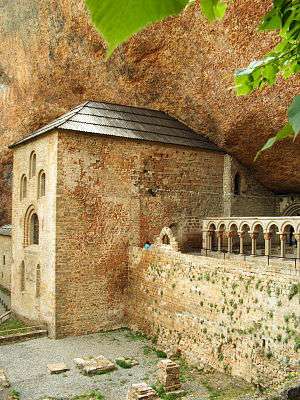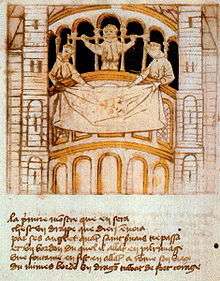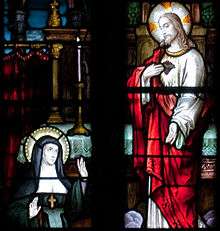Christian pilgrimage

Christianity has a strong tradition of pilgrimages, both to sites relevant to the New Testament narrative (especially in the Holy Land) and to sites associated with later saints or miracles.
Holy Land
The first pilgrimages were made to sites connected with the ministry of Jesus. Aside from the early example of Origen, who "in search of the traces of Jesus, the disciples and the prophets",[1] already found local folk prompt to show him the actual location of the Gadarene swine in the mid-3rd century, surviving descriptions of Christian pilgrimages to the Holy Land and Jerusalem date from the 4th century. The Itinerarium Burdigalense ("Bordeaux Itinerary"), the oldest surviving Christian itinerarium, was written by the anonymous "Pilgrim of Bordeaux" recounting the stages of a pilgrimage to Jerusalem in the years 333 and 334.[2]
Pilgrimage was encouraged by church fathers like Saint Jerome and established by Helena, the mother of Constantine the Great. Pilgrimages also began to be made to Rome and other sites associated with the Apostles, Saints and Christian martyrs, as well as to places where there have been apparitions of the Virgin Mary. Pilgrimage to Rome became a common destination for pilgrims from throughout Western Christianity in the medieval period, and important sites were listed in travel-guides such as the 12th-century Mirabilia Urbis Romae.
In the 7th century, the Holy Land fell to the Muslim conquests,[3] and as pilgrimage to the Holy Land now became more difficult for European Christians, major pilgrimage sites developed in Western Europe, notably Santiago de Compostela in the 9th century.
Political relationships between the Muslim caliphates and the Christian kingdoms of Europe remained in a state of suspended truce, allowing the continuation of Christian pilgrimages into Muslim-controlled lands, at least in intervals; for example, the Fatimid Caliph al-Hakim bi-Amr Allah ordered the destruction of the Church of the Holy Sepulchre, only to have his successor allow the Byzantine Empire to rebuild it.[4] The Seljuk Turks now systematically disrupted Christian pilgrimage routes, which became one of the major factors triggering the crusades later in the 11th century.
The crusades were at first a success, the Crusader states, especially the kingdom of Jerusalem, guaranteeing safe access to the Holy Land for Christian pilgrims during the 12th century, but the enterprise of the crusades was ultimately doomed to failure, and the Holy Land was entirely re-conquered by the Ayyubids by the end of the 13th century.
Under the Ottoman Empire travel in Palestine was once again restricted and dangerous. Modern pilgrimages in the Holy Land may be said to have received an early impetus from the scholar Ernest Renan, whose twenty-four days in Palestine, recounted in his Vie de Jésus (published 1863) found the resonance of the New Testament at every turn.
Rome
Rome has been a major Christian pilgrimage site since the Middle Ages. Pilgrimages to Rome can involve visits to a large number of sites, both within the Vatican City and in Italian territory. A popular stopping point is the Pilate's stairs: these are, according to the Christian tradition, the steps that led up to the praetorium of Pontius Pilate in Jerusalem, which Jesus Christ stood on during his Passion on his way to trial.[5] The stairs were, reputedly, brought to Rome by St. Helena in the 4th Century. For centuries, the Scala Santa has attracted Christian pilgrims who wished to honour the Passion of Jesus. Object of pilgrimage are also several catacombs built in the Roman age, in which Christians prayed, buried their dead and performed worship during periods of persecution, and various national churches (among them San Luigi dei francesi and Santa Maria dell'Anima), or churches associated with individual religious orders, such as the Jesuit Churches of Jesus and Sant'Ignazio. Traditionally, pilgrims in Rome visit the seven pilgrim churches (Italian: Le sette chiese) in 24 hours. This custom, mandatory for each pilgrim in the Middle Ages, was codified in the 16th century by Saint Philip Neri. The seven churches are the four major Basilicas (St Peter in Vatican, St Paul outside the Walls, St John in Lateran and Santa Maria Maggiore), while the other three are San Lorenzo fuori le mura (a palaeochristian Basilica), Santa Croce in Gerusalemme (a church founded by Helena, the mother of Constantine, which hosts fragments of wood attributed to the holy cross) and San Sebastiano fuori le mura (which lies on the Appian Way and is built above Roman catacombs).
Santiago de Compostela
At some point between 818 and 842,[6] during the reign of Alfonso II of Asturias, bishop Theodemar of Iria (d. 847) claimed to have found some remains which were attributed to Saint James the Greater. Around the place of the discovery a new settlement and centre of pilgrimage emerged, which was known to the author Usuard in 865[7] and which was called Compostella by the 10th century.
The cult of Saint James of Compostela was just one of many arising throughout northern Iberia during the 10th and 11th centuries, as rulers encouraged their own region-specific cults, such as Saint Eulalia in Oviedo and Saint Aemilian in Castile.[8] After the centre of Asturian political power moved from Oviedo to León in 910, Compostela became more politically relevant, and several kings of Galicia and of León were acclaimed by the Galician noblemen and crowned and anointed by the local bishop at the cathedral, among them Ordoño IV in 958,[9] Bermudo II in 982, and Alfonso VII in 1111, by which time Compostela had become capital of the Kingdom of Galicia. Later, 12th-century kings were also sepulchered in the cathedral, namely Fernando II and Alfonso IX, last of the Kings of León and Galicia before both kingdoms were united with the Kingdom of Castile.
According to some authors, by the middle years of the 11th century the site had already become a pan-European place of peregrination,[10] while others maintain that the cult to Saint James was before 11–12th centuries an essentially Galician affair, supported by Asturian and Leonese kings to win over faltering Galician loyalties.[8] Santiago would become in the course of the following century a main Catholic shrine second only to Rome and Jerusalem. In the 12th century, under the impulse of bishop Diego Gelmírez, Compostela became an archbishopric, attracting a large and multinational population. Under the rule of this prelate, the townspeople rebelled, headed by the local council, beginning a secular tradition of confrontation by the people of the city—who fought for self-government—against the local bishop, the secular and jurisdictional lord of the city and of its fief, the semi-independent Terra de Santiago ("land of Saint James"). The culminating moment in this confrontation was reached in the 14th century, when the new prelate, the Frenchman Bérenger de Landore, treacherously executed the counselors of the city in his castle of A Rocha Forte ("the strong rock, castle"), after inviting them for talks.
Maastricht-Aachen-Kornelimünster

.jpg)
Combined septennial pilgrimages in the Dutch-German towns of Maastricht, Aachen and Kornelimünster were held at least since the 14th century. The German word Heiligtumsfahrt means "journey to the holy relics". In all three places important relics could be seen: in Maastricht relics of the True Cross, the girdle of Mary, the arm of Saint Thomas and various relics of Saint Servatius; in Aachen the nappy and loin cloth of Jesus, the dress of Mary, the decapitation cloth of John the Baptist, and the remains of Charlemagne; and in Kornelimünster the loincloth, the sudarium and the shroud of Jesus, as well as the skull of Pope Cornelius. In Maastricht some relics were shown from the dwarf gallery of St Servatius' Church to the pilgrims gathered in the square; in Aachen the same was done from the purpose-built tower gallery between the dome and the westwork tower of Aachen Cathedral. The popularity of the Maastricht-Aachen-Kornelimünster pilgrimage reached its zenith in the 15th century when up to 140,000 pilgrims visited these towns in mid-July.[11] After a break of about 150 years, the pilgrimages were revived in the 19th century. The Aachen and Kornelimünster pilgrimages are still synchronised but the Maastricht pilgrimage takes place 3 years earlier. In 2011 the Maastricht pilgrimage drew around 175,000 visitors;[12] Aachen had in 2014 around 125,000 pilgrims.[13]
_-_Jul_2008_(cropped).jpg)
Fátima
Marian apparitions are also responsible for tens of millions of Christian pilgrimages worldwide.[14] The Sanctuary of Our Lady of Fátima, in Cova da Iria, Fátima, Portugal, became one of the most visited shrines with between 6 and 8 million pilgrims per year.[15][16]
Latin America
Latin America has a number of pilgrimage sites, which have been studied by anthropologists, historians, and scholars of religion.[17][18] In Mesoamerica, some pre-date the arrival of Europeans and were subsequently transformed to Christian pilgrimage sites.[19] One such is the Hill of Tepeyac with the Basilica of Our Lady of Guadalupe outside Mexico City, said to be the site of the apparition of the Virgin of Guadalupe.[20]
See also
- HCPT – The Pilgrimage Trust
- List of Christian pilgrimage sites
- List of pilgrimage churches (containing, as of March 2016, only Catholic sites)
Further reading
- Brown, Peter. The Cult of the Saints: Its Rise and Function in Latin Christianity. Chicago 1981.
- Christian, William A. Local Religion in Sixteenth-Century Spain. Princeton 1989.
- Crumrine, N. Ross and E. Alan Morinis. Pilgrimage in Latin America. Westport CT 1991.
- Turner, Victor and Edith Turner. Image and Pilgrimage in Christian Culture: Anthropological Perspectives. New York 1978.
References
- ↑ Quoted in Robin Lane Fox, The Unauthorized Version, 1992:235.
- ↑ General context of early Christian pilgrimage is provided by E.D. Hunt, Holy Land Pilgrimage in the Late Roman Empire AD 312–460 1982.
- ↑ Wickham Inheritance of Rome p. 280
- ↑ Pringle "Architecture in Latin East" Oxford History of the Crusades p. 157
- ↑ Steps Jesus walked to trial restored to glory, Daily Telegraph, Malcolm Moore, 14 June 2007
- ↑ Fletcher, R. A. (1984). Saint James's catapult : the life and times of Diego Gelmírez of Santiago de Compostela. Oxford [Oxfordshire]: Clarendon Press. ISBN 978-0-19-822581-2.
- ↑ Fletcher, R. A. (1984). Saint James's catapult: the life and times of Diego Gelmírez of Santiago de Compostela. Oxford [Oxfordshire]: Clarendon Press. p. 56. ISBN 978-0-19-822581-2.
- 1 2 Collins, Roger (1983). Early Medieval Spain. New York: St. Martin's Press. p. 238. ISBN 0-312-22464-8.
- ↑ Portela Silva, Ermelindo (2001). García II de Galicia, el rey y el reino (1065–1090). Burgos: La Olmeda. p. 165. ISBN 84-89915-16-4.
- ↑ Fletcher, R. A. (1984). Saint James's catapult : the life and times of Diego Gelmírez of Santiago de Compostela. Oxford [Oxfordshire]: Clarendon Press. p. 53. ISBN 978-0-19-822581-2.
- ↑ A.M. Koldeweij (1990): 'Pelgrimages'. In: Th.J. van Rensch, A.M. Koldeweij, R.M. de la Haye, M.L. de Kreek (1990): Hemelse trektochten. Broederschappen in Maastricht 1400-1850, pp. 107-113. Vierkant Maastricht #16. Stichting Historische Reeks Maastricht, Maastricht. ISBN 90-70356-55-4.
- ↑ 'Maastricht, H. Servaas (Servatius)' on website meertens.knaw.nl
- ↑ 'Mehr Pilger als erwartet kamen nach Aachen', in: Die Welt 30 June 2014.
- ↑ "Popular Catholic Shrines". Retrieved 8 September 2016.
- ↑ "Religion moves 330 million tourists a year and six million go to Fátima", Diário de Notícias, 19 February 2017.
- ↑ "Fátima expects to receive 8 million visitors in 2017", in Sapo20, 15 December 2016.
- ↑ N. Ross Crumrine and E. Alan Morinis, Pilgrimage in Latin America. Westport CT 1991.
- ↑ Thomas S. Bremer, "Pilgrimage," in Oxford Encyclopedia of Mesoamerican Cultures, David Carrasco, ed. Vol. 3, pp. 1–3. New York: Oxford University Press 2001.
- ↑ George A. Kubler. "Pre-Columbian Pilgrimages in Mesoamerica," In Fourth Palenque round Table, edited by Elizabeth P. Benson, 313-16. San Francisco 1985.
- ↑ Stafford Poole. Our Lady of Guadalupe: The Origins and Sources of a Mexican National Symbol, 1531–1797. Tucson: University of Arizona Press 1995.
External links
- Database of Shrines and Pilgrimage in the Netherlands
- Galilean Destinations for Christians

